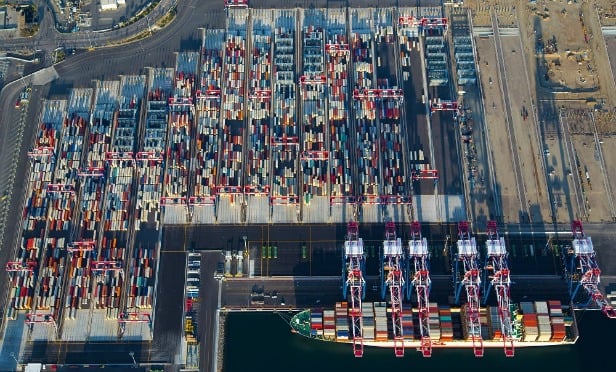 Los Angeles is leading the nation for industrial vacancy rate. According to a new report from Newmark Knight Frank, the market has a 1.3% vacancy rate and has seen 21 consecutive quarters below 2%. Net absorption also continues to outpace new construction activity, with 4.7 million square feet absorbed in 2019. The activity is largely attributed to the robust port system in the Los Angeles area.
Los Angeles is leading the nation for industrial vacancy rate. According to a new report from Newmark Knight Frank, the market has a 1.3% vacancy rate and has seen 21 consecutive quarters below 2%. Net absorption also continues to outpace new construction activity, with 4.7 million square feet absorbed in 2019. The activity is largely attributed to the robust port system in the Los Angeles area.
"More than 40% of the nation's imports enter the U.S. through the Ports of Los Angeles and Long Beach, which combined are the nation's busiest seaport and eighth in the world. Roughly 40% of inbound cargo stays in Southern California to clothe, feed and entertain its 22.5 million residents," John McMillan, vice chairman at Newmark Knight Frank, tells GlobeSt.com. "2019 will likely go down as the third busiest year on record for the ports when December's numbers are published. Transport costs account for 50% of the average distributor's overhead, so it is in most occupier's best interest to operate facilities within reasonable proximity of the ports."
E-commerce activity was the driver of port activity in 2019, and as a result, led industrial leasing demand as well. "E-Commerce is dominating the headlines, but Los Angeles is also home to companies large and small doing food processing, aerospace, bio-med, garment design/sales, freezer warehouses, and all sorts of manufacturing companies," says McMillan. "The entrepreneurial spirit, intellectual capital, educated labor force, supply chain infrastructure, and of course the Ports and weather, are all here. We just don't have enough industrial land and buildings to handle the growth."
The port system isn't the only factor driving industrial activity to record highs year-after-year. McMillan notes the manufacturing industry and supply shortage are also putting downward pressure on the availability rate. "We also have a strong manufacturing base given the labor force, weather, and a myriad of other factors, although that continues to dwindle every year due to labor costs, regulations and so on," he says. "Southern California also is a great place to live, vacation, shop, go to college, start a business, etc., so land is extremely valuable for dozens of other uses other than industrial. If you don't have industrial zoned land, you can't add new industrial supply."
The 21-quarter streak will not likely be broken in 2020. McMillan expects the ports to continue to perform well in 2020 and expects strong rent growth for industrial product. "U.S. retail sales are expected to post a gain of 3%+/- in 2019, and that's despite tariffs on over $550.0 billion worth of Chinese products at the time. Election years are always wild cards, and Mid-East tensions don't help, but consumer spending is the critical metric for industrial real estate, and it appears to be chugging along at a steady pace, so we expect current trends to continue," he says. "Competition for new supply will remain fierce, and vacancy should hover in the 1.0% range. Finally, we expect rents to increase by 6.0% +/- in 2020."
© Touchpoint Markets, All Rights Reserved. Request academic re-use from www.copyright.com. All other uses, submit a request to [email protected]. For more inforrmation visit Asset & Logo Licensing.






